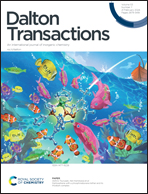A novel blue emitting phosphor Ca1−ySryScBO4:Bi3+ with zero-thermal quenching for multi-scenario application†
Abstract
In recent years, Bi3+ activated phosphors have received a lot of attention from researchers; however, the performance and application areas of phosphors are yet to be developed. In this work, a series of CaScBO4(CSBO):xBi3+ phosphors were successfully prepared using a high-temperature solid-state method. Under UV excitation, blue light emission was achieved at 430 nm with a quantum yield of 91%, and at 423 K, the emission intensity retained 82.8% of the original intensity at 298 K. By crystal field engineering, the substitution of Sr2+ at the Ca2+ site enhances the temperature stability of the material, and at 423 K, 473 K and 573 K, the samples maintain 104%, 103% and 85% of the emission intensity at room temperature, respectively. It indicates that the cation substitution causes the increase in the oxygen vacancy concentration, and the oxygen vacancy defect compensates the energy lost in electrons at high temperature, producing resistance to anti-TQ performance. Finally, a blue-violet LED was fabricated by using the phosphor and an ultraviolet LED chip, and white LEDs (CCT = 4683 K, Ra = 89.7) were obtained by co-packaging this phosphor with commercial phosphors and a UV chip. Importantly, the great potential of this phosphor in the field of plant lighting and biocontrol can be demonstrated.



 Please wait while we load your content...
Please wait while we load your content...